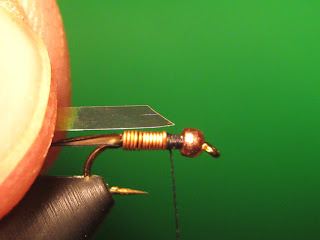Material Needed:
Bead: I am using a 5/64, 2mm gold tungsten bead.
Hook: Standard nymph hook, size #12-22
Thread: Black UNI 8/0.
Tail: Brown goose biots.
Rib: Gold wire.
Body: Peacock herl, or Peacock dubbing.
Legs: Brown hackle, wrapped.
Wings: White goose biots.
Place your bead on the hook, and start your thread.
Wrap to the back of the hook shank, and build up a little lump of thread to help keep your goose biots separated.
Select two goose biots, and place them back to back.
Tie them in just in front of your thread lump.
The length of the tail should equal the length of the hook shank.
Trim the tag ends.....
...and tie them down.
Tie in your gold wire rib.
Dub some peacock dubbing onto your thread.
You could also just tie in some peacock herl, and wrap that instead of dubbing.
Wrap your dubbed thread to build up a body.
Wrap your gold wire rib forward, tie it off, and break, or cut it.
Tie in some brown hackle and give 2 or 3 wraps.
Trim the top hackle fibers off.
Select two white goose biots to use as wings.
They should both be facing the same direction, not back to back.
Tie in your wings. They should be about the length of the hook shank.
Apply some head cement directly to the thread.
I use Sally Hansen's Hard as Nails.
Whip finish, and cut your thread.
































































